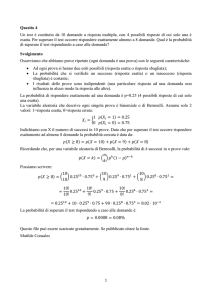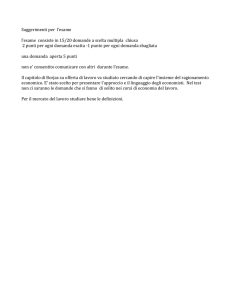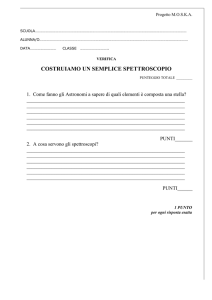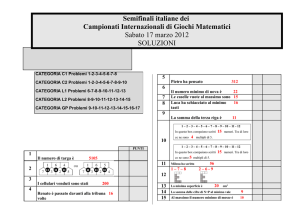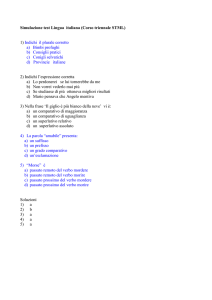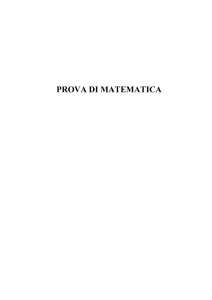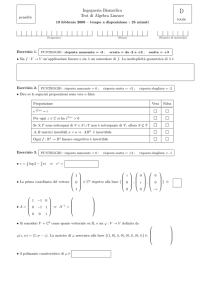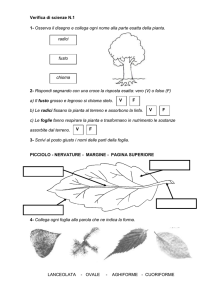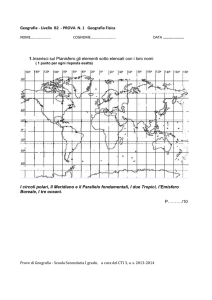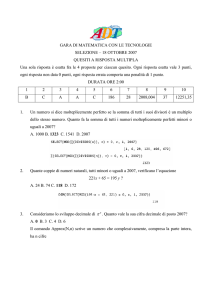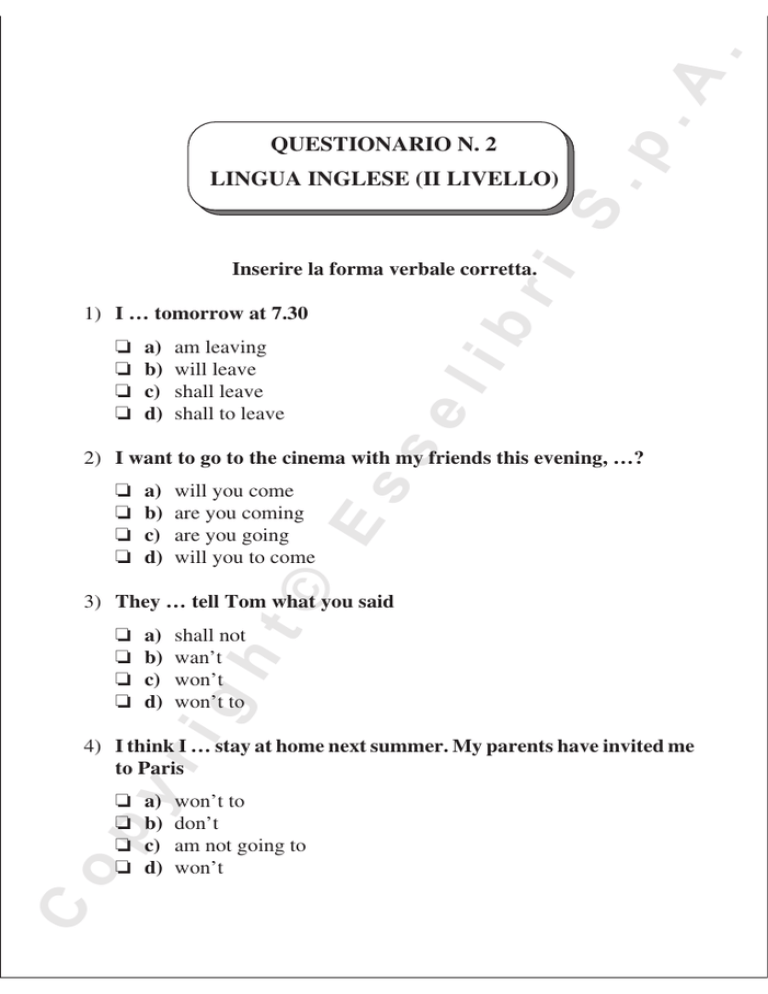
.
A
p.
QUESTIONARIO N. 2
S.
LINGUA INGLESE (II LIVELLO)
br
i
Inserire la forma verbale corretta.
1) I … tomorrow at 7.30
am leaving
will leave
shall leave
shall to leave
li
a)
b)
c)
d)
se
❏
❏
❏
❏
a)
b)
c)
d)
will you come
are you coming
are you going
will you to come
©
❏
❏
❏
❏
Es
2) I want to go to the cinema with my friends this evening, …?
3) They … tell Tom what you said
shall not
wan’t
won’t
won’t to
ht
a)
b)
c)
d)
ig
❏
❏
❏
❏
yr
4) I think I … stay at home next summer. My parents have invited me
to Paris
a)
b)
c)
d)
C
op
❏
❏
❏
❏
won’t to
don’t
am not going to
won’t
36
A
.
Questionario n. 2
a)
b)
c)
d)
will to leave
going to travel
are going to travel
is going to travel
S.
❏
❏
❏
❏
p.
5) We … by train, but it depends on the strike
read
readed
has read
have readed
br
a)
b)
c)
d)
li
❏
❏
❏
❏
i
6) Yesterday Tom … the newspaper all the day
a)
b)
c)
d)
traveled
have travelled
had travelled
travelled
Es
❏
❏
❏
❏
se
7) John … all around Europe last year
8) When I … to school I … very hard
gone - was studying
went - had studyed
went - studied
came - study
©
a)
b)
c)
d)
ht
❏
❏
❏
❏
a)
b)
c)
d)
has smoked
smoked
was smoking
have smoked
yr
❏
❏
❏
❏
ig
9) Today I … ten cigarettes
C
op
10) Peter … married with Susan; now they …
❏
❏
❏
❏
a)
b)
c)
d)
was - are separated
is - separated
was - has separated
-; are separated
37
A
.
Lingua inglese (II livello)
a)
b)
c)
d)
did you arrive
have you arrived
are you arrived
did you arrived
S.
❏
❏
❏
❏
p.
11) What time …? Only one hour ago
left you
leave you
do you leaved
did you leave
br
a)
b)
c)
d)
a)
b)
c)
d)
told - had fallen
had told - had fallen
told - had falling
have told - had fallen
Es
❏
❏
❏
❏
se
13) He … me he … in love with Susan
li
❏
❏
❏
❏
i
12) What time … yesterday?
14) While I … someone knocked at the door
am sleeping
was sleeping
slept
was sleepying
©
a)
b)
c)
d)
ht
❏
❏
❏
❏
a)
b)
c)
d)
kept
keeped
keep
keept
C
op
yr
❏
❏
❏
❏
ig
15) Where do you keep the butter? The butter is … here
38
A
.
Questionario n. 2
p.
Inserire la preposizione giusta.
16) Romeo and Juliet is a play … Shakespeare
from
to
of
by
S.
a)
b)
c)
d)
i
❏
❏
❏
❏
with
from
by
to
li
a)
b)
c)
d)
se
❏
❏
❏
❏
br
17) I came to Naples … train
18) The room was filled … smoke
by
with
of
from
Es
a)
b)
c)
d)
©
❏
❏
❏
❏
ht
Completare la frase.
19) My hair is … yours
less curly
least curly than
less curly of
less curly than
ig
a)
b)
c)
d)
yr
❏
❏
❏
❏
20) This summer is … last year
a)
b)
c)
d)
C
op
❏
❏
❏
❏
warmer than
more warm than
warmer of
more warm of
39
A
.
Lingua inglese (II livello)
a)
b)
c)
d)
the most useful
the more useful
most useful
more useful
S.
❏
❏
❏
❏
p.
21) My English book is … I have ever had
22) His … son is still at school
i
eldest
bigger
younger
the young
br
a)
b)
c)
d)
23) This is the … film I have ever seen
worse
worsts
worsest
worst
se
a)
b)
c)
d)
Es
❏
❏
❏
❏
li
❏
❏
❏
❏
a)
b)
c)
d)
as tall as
tall as
tall like
so tall as
ht
❏
❏
❏
❏
©
24) A boy of sixteen is often … his father
a)
b)
c)
d)
first - second
the first - the second
first - last
former - latter
yr
❏
❏
❏
❏
ig
25) Joe and Ted are good friends. The … lives in England, the … lives
in America
C
op
26) They can speak … English … French
❏
❏
❏
❏
a)
b)
c)
d)
both - and
both - than
both - that
both - each
.
A
p.
AL QUESTIONARIO N. 2
br
i
1) Risposta esatta: a
S.
RISPOSTE
se
li
Per esprimere azioni future già programmate, della cui attuazione si è praticamente certi, si usa il present continuous. Ad es.: una persona che ha già il
biglietto, che è dunque certa di partire, dice: I’m leaving to America.
Nei casi in cui si ha la certezza di un evento futuro, si può usare anche il presente
semplice: Ad es.: tomorrow is monday.
2) Risposta esatta: a
ht
3) Risposta esatta: c
©
Es
Il futuro si forma con gli ausiliari will e shall più l’infinito del verbo senza to.
Ad es.: I shall go to America; you will miss me.
La forma contratta è I’ll / you’ll / etc. Ad es.: I’ll go to America. You’ll miss me.
La forma interrogativa si ottiene facendo precedere il soggetto dall’ausiliare.
Ad es.: will you go to America?
La forma negativa si ottiene aggiungendo all’ausiliare la negazione not. La
forma contratta di will not è won’t; di shall not è shan’t.
yr
ig
Will e Shall si usano per esprimere un progetto vago per la cui realizzazione non
è stato fatto ancora nulla di concreto. La persona che dice I will leave to America
non ha ancora acquistato il biglietto aereo e non conosce la data della partenza.
Will e shall si possono usare anche per enunciare una decisione. Ad es.: I’ll pay
the bill now; per formulare una promessa. Ad es.: I’ll write you; per fare una
minaccia. Ad es.: I’ll kill you! Infine possono essere usati per esprimere un
divieto. Ad es.: you shan’t do it.
op
4) Risposta esatta: d
C
5) Risposta esatta: c
Quando con il futuro si intende esprimere una precisa intenzione, o un evento
probabile, si usa to be going to + l’infinito del verbo senza to. Ad es.: I’m going
54
A
.
Risposte al questionario n. 2
p.
to leave to America. La persona che usa questa forma è intenzionata ad andare
in America e si accinge a organizzare concretamente il viaggio.
S.
6) Risposta esatta: a
Il passato dei verbi irregolari corrisponde alla seconda voce del paradigma di un
verbo ed è uguale per tutte le persone.
i
7) Risposta esatta: d
Es
se
li
br
I verbi regolari formano il passato e il participio passato aggiungendo all’infinito del verbo senza to la desinenza -ed, o semplicemente -d, se il verbo termina
in -e. Ad es.: to work - worked; to live - lived.
I verbi che terminano in -y preceduta da consonante mutano la -y in -i. Ad es.:
to try - tried, se è preceduta da vocale si aggiunge solo -ed, ad es.: to play played. I monosillabi, i bisillabi accentati sull’ultima sillaba, e le parole
terminanti in -l, se terminano con una sola consonante preceduta da un’unica
vocale, raddoppiano la consonante finale. Ad es.: To stop - stopped; to refer referred; travel - travelled.
Il passato si usa per esprimere un’azione compiuta e conclusasi nel passato. Ad
es.: Yesterday I went to the cinema.
9) Risposta esatta: d
©
8) Risposta esatta: c
ig
ht
Il passato prossimo (present perfect) si forma con il presente di to have + il
participio passato del verbo. Ad es.: I have been; I have gone.
Il present perfect si usa per esprimere un’azione passata i cui effetti durano
ancora nel presente. Si usa anche quando l’azione passata, benché conclusa,
costituisce un’esperienza. Ad es.: have you ever been to America?
yr
10) Risposta esatta: a
11) Risposta esatta: a
op
12) Risposta esatta: d
C
13) Risposta esatta: a
Il trapassato prossimo si forma con il passato del verbo to have (had) + il
participio passato del verbo da coniugare.
55
A
.
Lingua inglese (II livello)
p.
Il trapassato prossimo (past perfect) esprime un’azione che si è completata nel
passato prima di un’altra azione passata, ad es.: when I telephoned Sue, she had
gone out.
S.
14) Risposta esatta: b
br
i
Il past continuous si usa per esprimere un’azione che si stava svolgendo in un
determinato momento del passato, ovvero, contemporaneamente ad un’altra
(sempre nel passato). Ad es.: Leggeva (stava leggendo) quando entrai: He was
reading when I came in. Quando esprime un’azione continuamente ripetuta nel
passato per un periodo limitato. Ad es.: Prima di sposarsi beveva sempre vino
(continuava a bere): Before getting married, he was always drinking wine.
li
15) Risposta esatta: a
Es
se
Il participio passato (past participle) dei verbi irregolari corrisponde alla terza
voce del paradigma di un verbo. Esso è invariabile ed è utilizzato principalmente: per costruire i tempi composti di to have; per accompagnare to be nella
costruzione della forma passiva, ad es.: she was seen with Mark last night; come
aggettivo, ad es.: Lost property office.
16) Risposta esatta: d
ht
©
Un errore frequente è quello di non distinguere tra i complementi d’agente, di
provenienza, di materia. Il complemento d’agente è introdotto dalla preposizione
by: the letter was written by me. Il complemento di provenienza da from: the letter
was sent from Rome. Il complemento di materia da with: the table was covered
with paper; ma «fatto di» si traduce made of …: the book is made of paper.
ig
17) Risposta esatta: c
18) Risposta esatta: b
yr
19) Risposta esatta: d
C
op
Il comparativo di minoranza si forma con less … than. Ad es.: Mary is less young
than Ann.
Il comparativo di maggioranza si forma aggiungendo la desinenza -er agli
aggettivi e agli avverbi monosillabi e agli aggettivi bisillabi che hanno l’accento
sull’ultima sillaba; negli altri casi si forma con more. Il termine di paragone è
introdotto da than. Ad es.: Mary is happier than Ann; Mary is more beautiful
than Ann.
56
A
.
Risposte al questionario n. 2
S.
p.
Il superlativo relativo di maggioranza si forma aggiungendo il suffisso -est agli
aggettivi monosillabi o bisillabi accentati sull’ultima sillaba e con the most negli
altri casi. Ad es.: Mary is the oldest of them; Mary is the most beautiful girl that
I know. Il superlativo relativo di minoranza si forma con the least. Ad es.: Mary
is the least rich in my family.
Il superlativo assoluto si forma con very o con most. Ad es.: Mary is very poor.
i
20) Risposta esatta: a
br
21) Risposta esatta: a
22) Risposta esatta: a
se
li
L’aggettivo old ha due forme per il superlativo: oldest ed eldest, che si usa in
riferimento all’età della persona, soprattutto nel contesto familiare.
N.B. il comparativo di old è elder se si riferisce al maggiore tra fratelli;
altrimenti è older.
Es
23) Risposta esatta: d
Alcuni aggettivi e avverbi formano il comparativo e il superlativo in modo
irregolare. I più comuni sono: good - better - best; bad - worse - worst.
©
24) Risposta esatta: a
ht
Il comparativo di uguaglianza degli aggettivi e degli avverbi si forma con as …
as nelle frasi affermative, con not so … as, in quelle negative. Ad es.: Mary is
as young as Ann; Mary isn’t so young as Ann.
ig
25) Risposta esatta: d
yr
Former traduce «il primo» di due cose o persone. È sempre preceduto dall’articolo
definito e viene usato generalmente in correlazione con the latter = il secondo tra due.
26) Risposta esatta: a
C
op
27) Risposta esatta: d
Quando il comparativo di maggioranza è preceduto dall’avverbio «sempre», in
inglese si omette e si traduce: a) ripetendo il comparativo unito dalla congiunzione and se l’aggettivo forma il comparativo col suffisso -er; b) premettendo
all’aggettivo more and more se l’aggettivo forma il comparativo con more.

